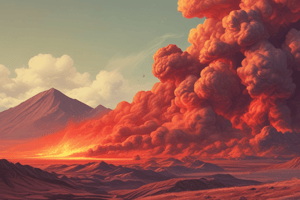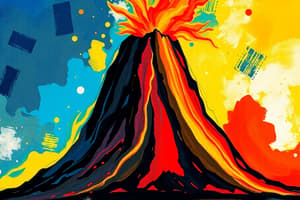Podcast
Questions and Answers
What is the name of the molten rock found beneath the earth's surface?
What is the name of the molten rock found beneath the earth's surface?
- Sill
- Ash
- Lava
- Magma (correct)
Which type of volcano is formed by an accumulation of volcanic cinder or blobs of cooled lava that erupts from one vent?
Which type of volcano is formed by an accumulation of volcanic cinder or blobs of cooled lava that erupts from one vent?
- Composite Volcano
- Shield Volcano
- Parasitic Cone Volcano
- Cinder Cone Volcano (correct)
What is the name of the flat piece of rock formed when magma hardens in a crack in a volcano?
What is the name of the flat piece of rock formed when magma hardens in a crack in a volcano?
- Laccolith
- Magma Chamber
- Parasitic Cone
- Sill (correct)
Which of the following volcanic features is NOT a part of a volcano?
Which of the following volcanic features is NOT a part of a volcano?
What is the primary reason for the formation of volcanoes at subduction zones?
What is the primary reason for the formation of volcanoes at subduction zones?
Which of these is NOT a characteristic of the Pacific Ring of Fire?
Which of these is NOT a characteristic of the Pacific Ring of Fire?
How are shield volcanoes formed?
How are shield volcanoes formed?
What is a parasitic cone?
What is a parasitic cone?
What is the definition of a dormant volcano?
What is the definition of a dormant volcano?
Which of the following is NOT an advantage of living near volcanoes?
Which of the following is NOT an advantage of living near volcanoes?
What term describes the movement of magma from the mantle to the Earth's surface?
What term describes the movement of magma from the mantle to the Earth's surface?
Which type of volcano is created by thick lava piling over vents, forming small circular mounds?
Which type of volcano is created by thick lava piling over vents, forming small circular mounds?
Which classification refers to a volcano that has not erupted for over 10,000 years?
Which classification refers to a volcano that has not erupted for over 10,000 years?
Flashcards
Lava Dome
Lava Dome
Small, circular mounds formed by thick, slow lava.
Active Volcano
Active Volcano
A volcano that has erupted at least once in the last 10,000 years.
Types of Volcanoes
Types of Volcanoes
Different volcanoes are classified as active, erupting, dormant, or inactive.
Disadvantages of Living Near Volcanoes
Disadvantages of Living Near Volcanoes
Signup and view all the flashcards
Advantages of Living Near Volcanoes
Advantages of Living Near Volcanoes
Signup and view all the flashcards
Vulcan Point
Vulcan Point
Signup and view all the flashcards
Pacific Ring of Fire
Pacific Ring of Fire
Signup and view all the flashcards
Volcanism
Volcanism
Signup and view all the flashcards
Parts of a Volcano
Parts of a Volcano
Signup and view all the flashcards
Subduction Zone
Subduction Zone
Signup and view all the flashcards
Cinder Cone Volcano
Cinder Cone Volcano
Signup and view all the flashcards
Composite Volcano
Composite Volcano
Signup and view all the flashcards
Shield Volcano
Shield Volcano
Signup and view all the flashcards
Study Notes
Vulcan Point
- The world's largest island within a lake, located on an island within a lake, which itself is on an island.
- Situated on Taal Volcano in the Philippines.
Pacific Ring of Fire
- A geological area characterized by frequent earthquakes and volcanic eruptions.
- The Philippines is located within this region.
Volcanism
- A phenomenon related to volcanoes and volcanic activity.
- The process of magma moving from the Earth's mantle to its surface.
Volcanoes
- Mountains with openings or vents that connect to a pool of molten rock beneath the surface.
- These openings allow magma, ash and gases to escape.
- Molten rock beneath the Earth's surface is called magma.
- When magma erupts at the surface it's called lava.
- Most volcanoes form due to geological activity along plate boundaries.
Volcano Formation
- Subduction Zone: Plates collide, one sinking into the mantle causing melting and subsequent magma rise through the other plate, resulting in a chain of volcanoes.
- Example: Mount Fuji in Japan.
- Rift Zone: Plates pull apart, creating a rift where magma rises from the Earth's sea floor.
- Example: Iceland, formed by the spreading boundary of the North American and Eurasian plates.
- Hot Spot: A rising column of superheated magma from deep within the mantle.
- Example: Hawaiian Islands.
Parts of a Volcano
- Magma: Molten rock beneath the Earth's surface.
- Magma Chamber: The underground reservoir where magma is stored.
- Parasitic Cone: A smaller, cone-shaped volcano, formed by the accumulation of volcanic debris secondary to a larger volcano.
- Sill: A flat, sheet-like intrusion of solidified magma within a volcano's crack.
- Vent: The opening where volcanic materials escape.
- Crater: The bowl-shaped depression surrounding the vent at the summit of a volcano.
- Laccolith: A sheet-like intrusion of magma that hardens within or between sedimentary rock layers.
- Layers of Ash: Small fragments of lava or rock, less than two millimeters in size, ejected during volcanic explosions.
- Ash Cloud: A cloud of ash formed by volcanic eruptions.
Volcano Types
- Cinder Cone: Cones formed by the accumulation of volcanic cinder or congealed basaltic lava ejected from a single vent.
- Example: Taal Volcano (Philippines) and Perikutan (Mexico).
- Composite: Volcanoes constructed by alternating layers of lava flows and ash.
- Example: Mount Fuji (Japan) and Mount Mayon (Philippines).
- Shield: Large, broad, gently sloping volcanoes formed by the eruption of basaltic lava flows.
- Example: Kilauea and Diamond Head (Hawaiian Islands).
- Lava Dome: Small, circular mounds formed by the accumulation of viscous lava around a vent.
- Example: Chaitan Lava Dome (Chile) and Lassen Peak (Western United States).
Philippine Volcanoes
- The Philippines has more than 100 volcanoes.
- Philippine Institute of Volcanology and Seismology (PHIVOLCS) categorizes volcanoes as:
- Active: Has erupted within the last 10,000 years.
- Erupting: Currently erupting.
- Dormant: Not currently erupting but expected to erupt again.
- Inactive: Has not erupted in over 10,000 years; also known as extinct or sleeping.
- Active: Has erupted within the last 10,000 years.
Advantages and Disadvantages of Living Near Volcanoes
- Disadvantages:
- Damage to land from volcanic materials.
- Landslides.
- Pollution.
- Impacts on weather patterns.
- Advantages:
- Volcanic soils are often fertile.
- Volcanic materials have industrial and chemical uses.
- Volcanic areas often attract tourists.
Key Concepts
- Volcanism is the process of magma moving from the Earth's mantle to its surface.
- Volcanic eruptions result from the release of pressure as magma rises to the surface.
- Different volcano types have distinct characteristics.
- Volcanoes range from active, erupting, dormant, to inactive stages.
- Living near volcanoes has both advantages and disadvantages.
Studying That Suits You
Use AI to generate personalized quizzes and flashcards to suit your learning preferences.




